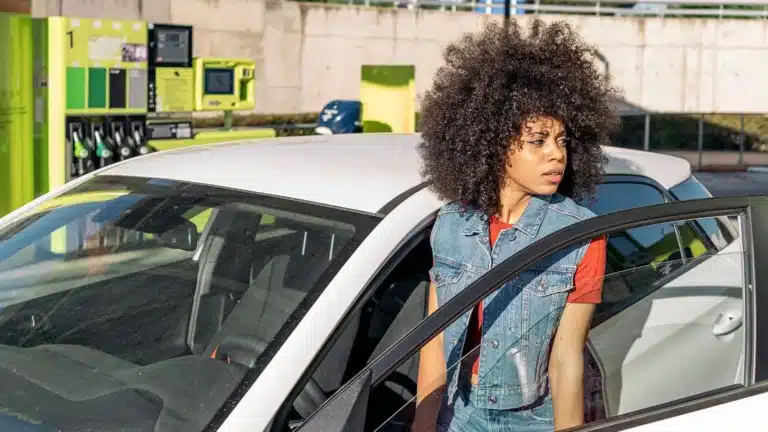Table of Contents
Why Small Accidents Can Lead to Big Insurance Headaches
Parking lot accidents may seem minor, but they often create outsized issues regarding fault and insurance claims. Because these incidents typically happen on private property, police may not respond, and traffic laws can be unclear. That lack of documentation makes it harder to prove who’s at fault and resolve claims quickly.
Even low-speed collisions or door dings can trigger disputes and increase premiums. That’s why understanding how these cases work—and how insurers handle them—is key. Tools like Beem help drivers compare insurers that treat minor accidents more fairly, reducing the long-term cost of a small mistake.
Common Types of Parking Lot Accidents
Parking lots are high-traffic, low-speed zones packed with tight turns, distracted drivers, and pedestrians. These common collision scenarios often lead to claims—and confusion over fault.
1. Backing-Out Collisions
When two vehicles reverse into each other or one backs into a parked car, fault can be disputed. Generally, the moving driver bears more responsibility—especially if the other vehicle was already in motion or stationary.
2. Pulling Forward Into Another Car
Drivers pulling out of spaces or into new ones sometimes misjudge clearance, hitting passing vehicles. In most cases, the pulling driver is at fault for failing to ensure a clear path.
3. Hitting a Parked Vehicle
If your car strikes a parked vehicle, you’re almost always considered at fault—even if the other car was poorly parked. Exceptions exist (e.g., cars blocking emergency lanes), but insurers expect drivers to avoid stationary objects.
4. Pedestrian Accidents
These incidents carry serious consequences. Even at low speeds, hitting a pedestrian can lead to significant injury claims. Drivers are typically held fully or mostly responsible, underscoring the need for extra caution in shared spaces.
Read related blog: Does Health Insurance Cover Motorcycle Accident Injuries?
How Fault Is Determined in Parking Lot Accidents
Since parking lots are private property, police often don’t issue reports unless there are injuries or serious damage. That leaves insurance companies to figure out fault—using state laws, available evidence, and often, a lot of guesswork.
State Laws Vary
- Comparative negligence: Fault is split based on percentages.
- Contributory negligence: Even partial fault can bar you from compensation.
Key Evidence Considered
- Vehicle damage location (e.g., rear bumper = someone was backing up)
- Witness statements
- Security footage
- Skid marks or signs of movement
Often, insurers split fault between drivers, meaning you could be on the hook for part of the costs even if you didn’t cause the accident entirely. These claims can take longer to resolve than on-road collisions.
Filing an Insurance Claim After a Parking Lot Accident
Documentation is everything. After a parking lot collision, take these steps:
- Photograph the scene—damage, vehicles, license plates, nearby signs, and layout.
- Get witness info, including the names and contact details of anyone who saw the incident.
- Check for security cameras—contact the property owner or mall security to request footage or an incident report.
- Notify your insurer promptly—provide them with all supporting evidence.
Pro tip: If damages are minor and near your deductible, it might be cheaper to pay out-of-pocket. A small claim could raise your rates more than the repair cost.
Read related blog: Does Auto Insurance Cover Bicycle Accidents?
How Parking Lot Accidents Affect Insurance Rates
Even low-speed accidents can lead to higher premiums if you’re found at fault. Depending on your insurer and driving history, these increases can last 3–5 years.
In No-Fault States
Even if your insurer pays regardless of fault, your risk profile increases after a claim. That alone can affect your renewal premium.
Severity Matters
- A minor scratch = small rate impact
- A pedestrian injury = major financial consequences
Some insurers offer accident forgiveness for first-time claims, but not all. Always ask your provider what options you have after an incident.
Coverage That Helps With Parking Lot Accidents
Having the right policy can soften the financial blow when a parking lot accident occurs.
Liability Coverage
Covers other people’s injuries or property damage when you’re at fault. Does not cover your own vehicle.
Collision Coverage
It pays for repairs to your car if you hit another vehicle or object after you meet your deductible.
Uninsured Motorist Coverage
It is useful for hit-and-runs or if the other driver lacks insurance. It helps pay for your vehicle repairs and medical costs.
Comprehensive Coverage
It protects against non-collision issues like vandalism, theft, falling objects, and weather damage—common risks in parking lots.
Read related blog: Does Insurance Cover Car Seat Replacement After Accident?
Tips to Avoid Parking Lot Accidents (and Premium Hikes)
A few small habits can go a long way in preventing parking lot accidents—and insurance claims:
- Park farther from store entrances. Less crowding means fewer chances of getting sideswiped or dinged.
- Back into parking spaces. Gives you better visibility when leaving.
- Drive slowly and cautiously. Always anticipate pedestrians and sudden stops.
- Install a dash cam. Video footage can clarify disputes and prove you weren’t at fault.
How Beem Helps Drivers With Smarter Insurance Choices
Many insurers raise rates sharply after even a minor parking lot incident. Beem helps you compare providers that treat these cases more reasonably.
- Find insurers with better claim forgiveness policies.
- Compare rates from companies that don’t overpenalize small claims.
- Get coverage that matches your actual risk.
Don’t overpay for one mistake. Use Beem to find fair, affordable car insurance today.
FAQs – Parking Lot Accidents and Insurance
Do police respond to parking lot accidents?
Not always. Since parking lots are private property, police may not file a report unless there are injuries or significant damage.
Who’s usually at fault in backing-up collisions?
If both cars are reversing, the fault is often split. If only one is moving, that driver is usually found at fault.
Will a parking lot accident raise my insurance?
It can—especially if you’re found at fault. Accident forgiveness may help, but small claims often lead to higher rates.
Should I file a claim for a minor dent or scratch?
Only if the repair cost is well above your deductible can a small claim cost you more in the long term through higher premiums.
Does comprehensive insurance cover vandalism in parking lots?
Yes. Comprehensive policies cover non-driving incidents like vandalism, theft, or storm damage while your car is parked.
Conclusion – Small Accidents, Big Insurance Impacts
Just because a parking lot accident happens at low speed doesn’t mean it’s low stakes. Insurance claims, fault disputes, and rising premiums can all follow. Knowing how to handle these situations—and having the right coverage—can save you time, stress, and money.
Don’t let one minor mishap lead to years of overpaying. Download Beem to easily compare insurers, find fair coverage, and confidently move on.















































